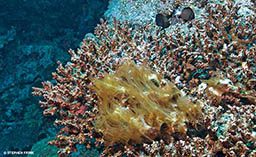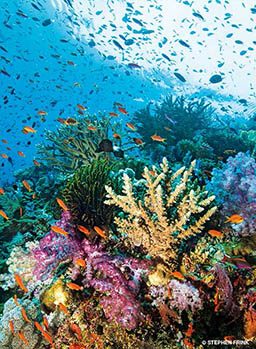Perfume is meant to allure — and healthy coral reefs and certain beneficial species of seaweed use sweet smells to entice young fish and baby corals. A healthy reef sends out attractive scents, broadcasting underwater like a siren to lure the young that will be the next generation of reef builders and dwellers.

According to experiments by coral biologist Danielle Dixson of the Georgia Institute of Technology and her colleagues, biochemical signatures indicate whether a reef is healthy and would make a good place to settle down. Dixson’s team experimented with coral and seaweed species offshore of Fiji, near marine protected areas as well as areas wide open to fishing. The team gardened underwater plots in the area, pruning some to be skewed toward algal mats and nasty seaweed species while enabling others to be more natural or even healthier. They tracked where coral and seaweed settled in the offshore plots and transects, and they counted the fish present in different areas. Fish appeared several times more often in healthier reef settings, and they avoided reefs smothered by noxious seaweed.
The researchers also conducted a series of experiments in the lab to determine what would happen in simplified systems compared to their real-world experiments. They plopped young fish and coral larvae into flumes spiked with good or bad scents. Invariably, both young fish and corals would head for the sweeter smells — even fighting currents to do so, the team recently reported in the journal Science.
“The thing that most shocked us was not that they could smell a good reef from a bad reef,” said Dixson’s co-author Mark Hay, a marine ecologist at Georgia Tech, nor that fish could swim away to wherever they wanted (usually to nearby marine protected areas, where the living is easy). But coral larvae are tiny saclike creatures “that can barely swim,” Hay said, and here they were, heading toward the good smells in the flumes and most likely in the real world too, while contending with “waves crashing around them, big enough that they were pushing us [humans] off the reef.”
Because the larvae can make a beeline to settle near sweeter-smelling healthy corals, they are much more in control of their survival than one might think, Hay said: “They glue themselves to the bottom, and that one choice that they make as a baby has so much impact on [their] future well-being.”

These behavioral insights also hint at one reason why reefs are in decline worldwide, according to Terry Hughes, director of the Australian Research Council Centre of Excellence for Coral Reef Studies at James Cook University, who commented on the research by email. “Often researchers ask the question ‘What killed the corals?’ when confronted with a decline in coral cover. This novel study shows convincingly that loss of corals, and [their] failure to recover, can also be linked to reproduction and settlement of larvae.” Because both fish and corals avoid polluted, seaweed-smothered reefs, that could lead to their further decline.
Could these sweet scents help protect coral reefs? The new results may lead to a simple solution, said Robert Steneck, a marine ecologist at the University of Maine: “If you just protect parrotfish [and other fish species that eat noxious seaweed], they can create a much more attractive nursery habitat,” for both fish and coral young. The study provides “interesting feedback that we need if we are going to manage these reefs into the next century.”
The next steps are to test that idea. Dixson and her team plan to train fishermen in Fiji to act like perfume purveyors: They could plant and tend to sweet-smelling coral and see if young fish and corals will come.
Explore More
© Alert Diver — Q1 Winter 2015